Measuring Sediment Transport Capacity of Concentrated Flow with Erosion Feeding Method
Abstract
1. Introduction
2. Materials and Methods
2.1. Mathematical Expression of the Erosion Process in Rill
2.2. Experimental Facilities
2.3. Soil Preparation
2.4. Experimental Design and Measurement Methods
3. Results
4. Discussion
4.1. Required Rill Length for Sediment Transport Capacity Measurement and the Equivalent Rill Length for the Proposed Facility
4.2. Comparisons with Previous Studies on the Similarly Constructed Rills
5. Conclusions
Author Contributions
Funding
Conflicts of Interest
References
- Lei, T.; Nearing, M.A.; Haghighi, K.; Bralts, V.F. Rill Erosion and Morphological Evolution: A Simulation Model. Water Resour. Res. 1998, 34, 3157–3168. [Google Scholar] [CrossRef]
- Nearing, M.; Norton, L.; Bulgakov, D.; Larionov, G.; West, L.; Dontsova, K. Hydraulics and Erosion in Eroding Rills. Water Resour. Res. 1997, 33, 865–876. [Google Scholar] [CrossRef]
- Zhang, G.; Wang, L.; Li, G.; Tang, K.; Cao, Y. Relationship between Sediment Particle Size and Transport Coefficient on Steep Slopes. Trans. ASABE 2011, 54, 869–874. [Google Scholar] [CrossRef]
- Zhang, G.; Shen, R.; Luo, R.; Cao, Y.; Zhang, X. Effects of Sediment Load on Hydraulics of Overland Flow on Steep Slopes. Earth Surf. Process. Landf. 2010, 35, 1811–1819. [Google Scholar] [CrossRef]
- Roo, A.P.J.D.; Wesseling, C.G.; Ritsema, C.J. LISEM: A Single-Event Physically Based Hydrological and Soil Erosion Model for Drainage Basins. I: Theory, Input and Output. Hydrol. Process. 1996, 10, 1107–1117. [Google Scholar] [CrossRef]
- Nearing, M.; Foster, G.; Lane, L.; Finkner, S. A Process-Based Soil Erosion Model for USDA-Water Erosion Prediction Project Technology. Trans. ASAE 1989, 32, 1587–1593. [Google Scholar] [CrossRef]
- Morgan, R.; Quinton, J.; Smith, R.; Govers, G.; Poesen, J.; Auerswald, K.; Chisci, G.; Torri, D.; Styczen, M. The European Soil Erosion Model (EUROSEM): A Dynamic Approach for Predicting Sediment Transport from Fields and Small Catchments. Earth Surf. Process. Landf. 1998, 23, 527–544. [Google Scholar] [CrossRef]
- Julien, P.; Simons, D. Sediment Transport Capacity of Overland Flow. Trans. ASAE 1985, 28, 755–762. [Google Scholar] [CrossRef]
- Finkner, S.; Nearing, M.; Foster, G.; Gilley, J. A Simplified Equation for Modeling Sediment Transport Capacity. Trans. ASAE 1989, 32, 1545–1550. [Google Scholar] [CrossRef]
- Govers, G. Empirical Relationships for Transport Capacity of Overland Flow; IAHS Press: Wallingford, UK, 1990. [Google Scholar]
- Ferro, V. Evaluating Overland Flow Sediment Transport Capacity. Hydrol. Process. 1998, 12, 1895–1910. [Google Scholar] [CrossRef]
- Lei, T.; Zhang, Q.; Zhao, J.; Tang, Z. A Laboratory Study of Sediment Transport Capacity in the Dynamic Process of Rill Erosion. Trans. ASAE 2001, 44, 1537. [Google Scholar] [CrossRef]
- Alonso, C.; Neibling, W.; Foster, G. Estimating Sediment Transport Capacity in Watershed Modeling. Trans. ASAE 1981, 24, 1211–1220. [Google Scholar] [CrossRef]
- Yalin, M.S. An Expression for Bed-Load Transportation. J. Hydraul. Div. 1963, 89, 221–250. [Google Scholar] [CrossRef]
- Yu, B.; Rose, C.; Ciesiolka, C.; Coughlan, K.; Fentie, B. Toward a Framework for Runoff and Soil Loss Prediction Using GUEST Technology. Soil Res. 1997, 35, 1191–1212. [Google Scholar] [CrossRef]
- Guy, B.T.; Dickenson, T.W.; Sohrabi, T.M.; Rudra, R.P. Development of an Empirical Model for Calculating Sediment-Transport Capacity in Shallow Overland Flows: Model Calibration. Biosyst. Eng. 2009, 103, 245–255. [Google Scholar] [CrossRef]
- Govers, G. Evaluation of Transporting Capacity Formulae for Overland Flow; University College London Press: London, UK, 1992. [Google Scholar]
- Nord, G.; Esteves, M.; Lapetite, J.; Hauet, A. Effect of Particle Density and Inflow Concentration of Suspended Sediment on Bedload Transport in Rill Flow. Earth Surf. Process. Landf. 2009, 34, 253–263. [Google Scholar] [CrossRef]
- Everaert, W. Empirical Relations for the Sediment Transport Capacity of Interrill Flow. Earth Surf. Process. Landf. 1991, 16, 513–532. [Google Scholar] [CrossRef]
- Guy, B.T.; Rudra, R.P.; Dickenson, T.W.; Sohrabi, T.M. Empirical Model for Calculating Sediment-Transport Capacity in Shallow Overland Flows: Model Development. Biosyst. Eng. 2009, 103, 105–115. [Google Scholar] [CrossRef]
- Poesen, J.; Savat, J. Particle-Size Separation during Erosion by Splash and Runoff; Wiley: Chichester, UK, 1980. [Google Scholar]
- Ghadiri, H.; Rose, C. Sorbed Chemical Transport in Overland Flow: II. Enrichment Ratio Variation with Erosion Processes. J. Environ. Qual. 1991, 20, 634. [Google Scholar] [CrossRef]
- Farenhorst, A.; Bryan, R.B. Particle Size Distribution of Sediment Transported by Shallow Flow. CATENA 1995, 25, 47–62. [Google Scholar] [CrossRef]
- Issa, O.M.; Bissonnais, Y.L.; Planchon, O.; Favis-Mortlock, D.; Silvera, N.; Wainwright, J. Soil Detachment and Transport on Field- and Laboratory-scale Interrill Areas: Erosion Processes and the Size-selectivity of Eroded Sediment. Earth Surf. Process. Landf. 2006, 31, 929–939. [Google Scholar] [CrossRef]
- Shih, H.-M.; Yang, C. Estimating Overland Flow Erosion Capacity Using Unit Stream Power. Int. J. Sediment Res. 2009, 24, 46–62. [Google Scholar] [CrossRef]
- Prosser, I.P.; Rustomji, P. Sediment Transport Capacity Relations for Overland Flow. Prog. Phys. Geogr. 2000, 24, 179–193. [Google Scholar] [CrossRef]
- Zhang, G.; Liu, Y.; Han, Y.; Zhang, X. Sediment Transport and Soil Detachment on Steep Slopes: I. Transport Capacity Estimation. Soil Sci. Soc. Am. J. 2009, 73, 1291. [Google Scholar] [CrossRef]
- Nearing, M.; Simanton, J.; Norton, L.; Bulygin, S.; Stone, J. Soil Erosion by Surface Water Flow on a Stony, Semiarid Hillslope. Earth Surf. Process. Landf. 1999, 24, 677–686. [Google Scholar] [CrossRef]
- Liu, B.; Nearing, M.; Shi, P.; Jia, Z. Slope Length Effects on Soil Loss for Steep Slopes. Soil Sci. Soc. Am. J. 2000, 64, 1759. [Google Scholar] [CrossRef]
- Yang, C.T. Unit Stream Power and Sediment Transport. J. Hydraul. Eng. 1972, 98, 1805–1826. [Google Scholar] [CrossRef]
- Chen, X.; Huang, Y.; Zhao, Y.; Mo, B.; Mi, H. Comparison of Loess and Purple Rill Erosions Measured with Volume Replacement Method. J. Hydrol. 2015, 530, 476–483. [Google Scholar] [CrossRef]
- Dong, Y.; Li, F.; Zhang, Q.; Lei, T. Determining Ephemeral Gully Erosion Process with the Volume Replacement Method. CATENA 2015, 131, 119–124. [Google Scholar] [CrossRef]
- Zhang, G.; Liu, B.; Zhang, X. Applicability of WEPP Sediment Transport Equation to Steep Slopes. Trans. ASABE 2008, 51, 1675–1681. [Google Scholar] [CrossRef]
- Nearing, M.A.; Lane, L.J.; Alberts, E.E.; Laflen, J.M. Prediction Technology for Soil Erosion by Water: Status and Research Needs. Soil. Sci. Soc. Am. J. 1990, 54, 1702–1711. [Google Scholar] [CrossRef]
- Polyakov, V.O.; Nearing, M.A. Sediment Transport in Rill Flow under Deposition and Detachment Conditions. Catena 2003, 51, 33–43. [Google Scholar] [CrossRef]
- Hillel, D. Environmental Soil Physics; Academic Press: San Diego, CA, USA, 1998; pp. 61–65. [Google Scholar]
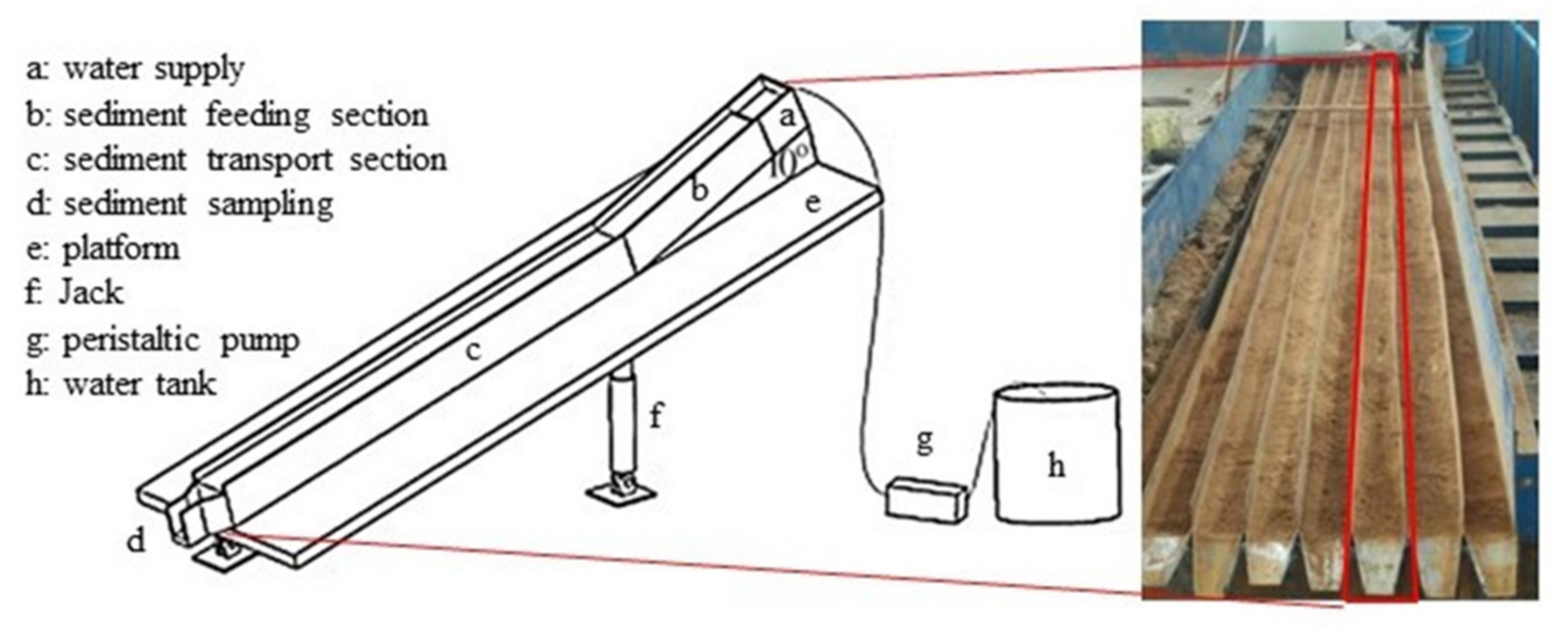
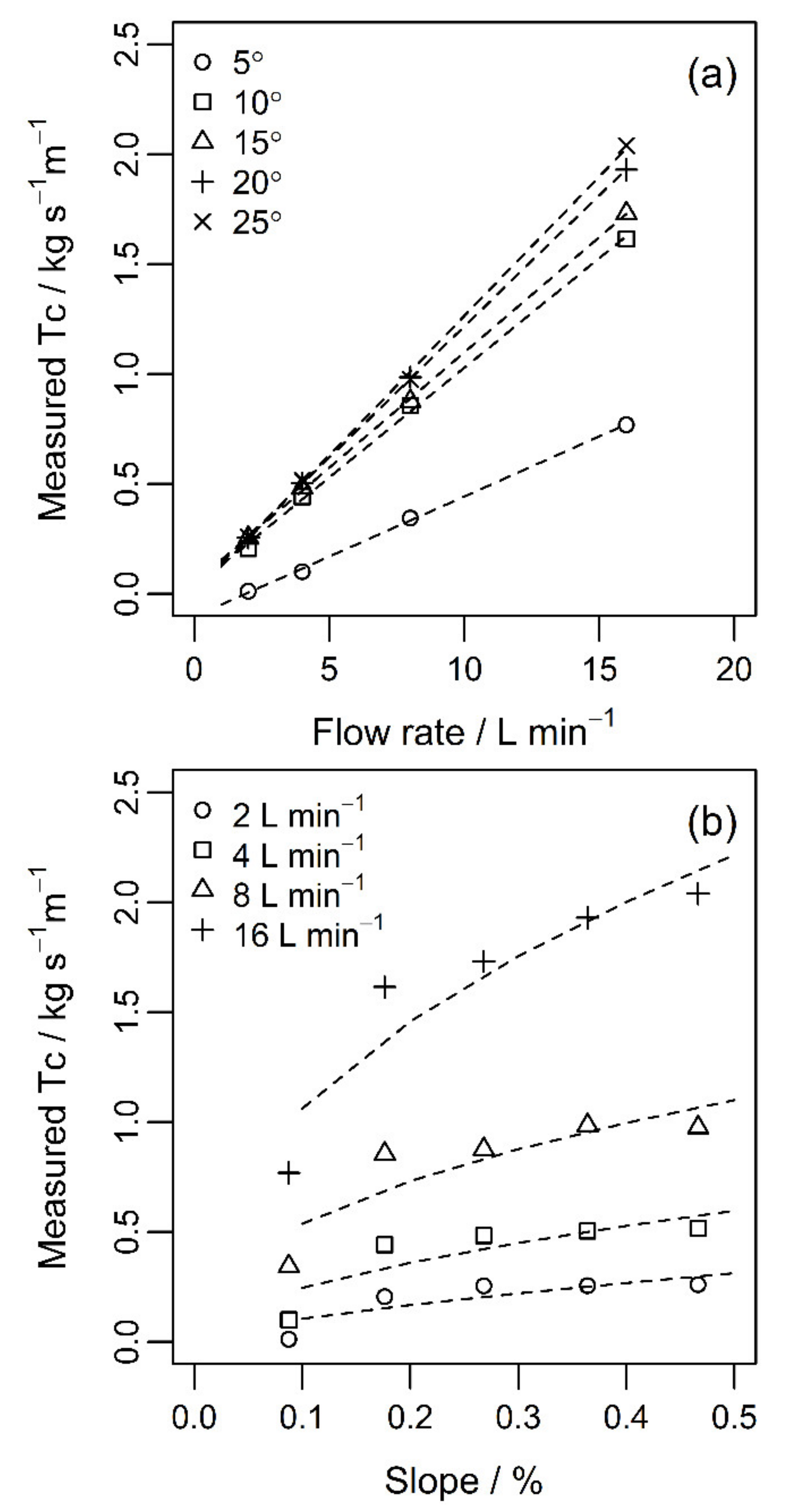
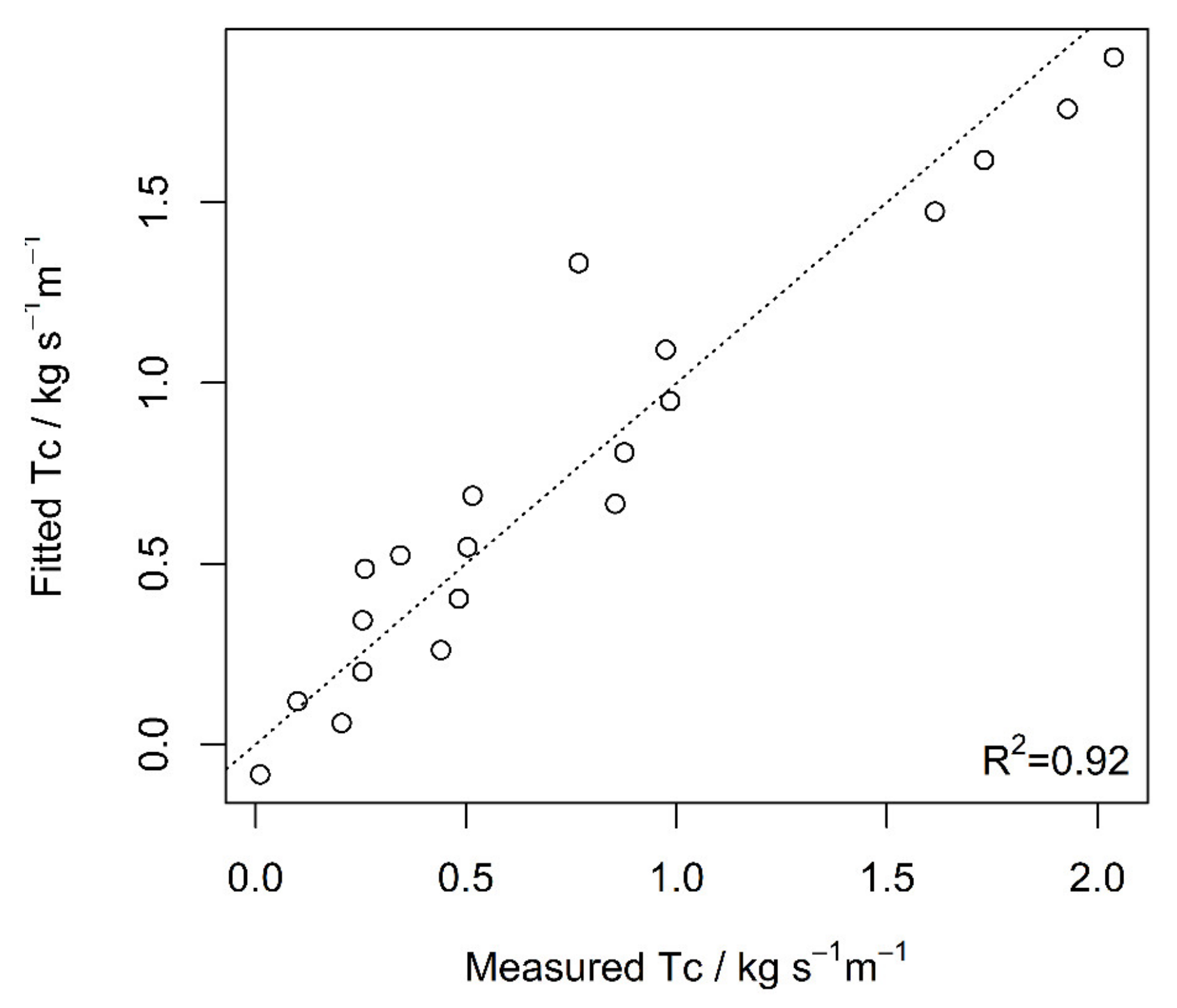
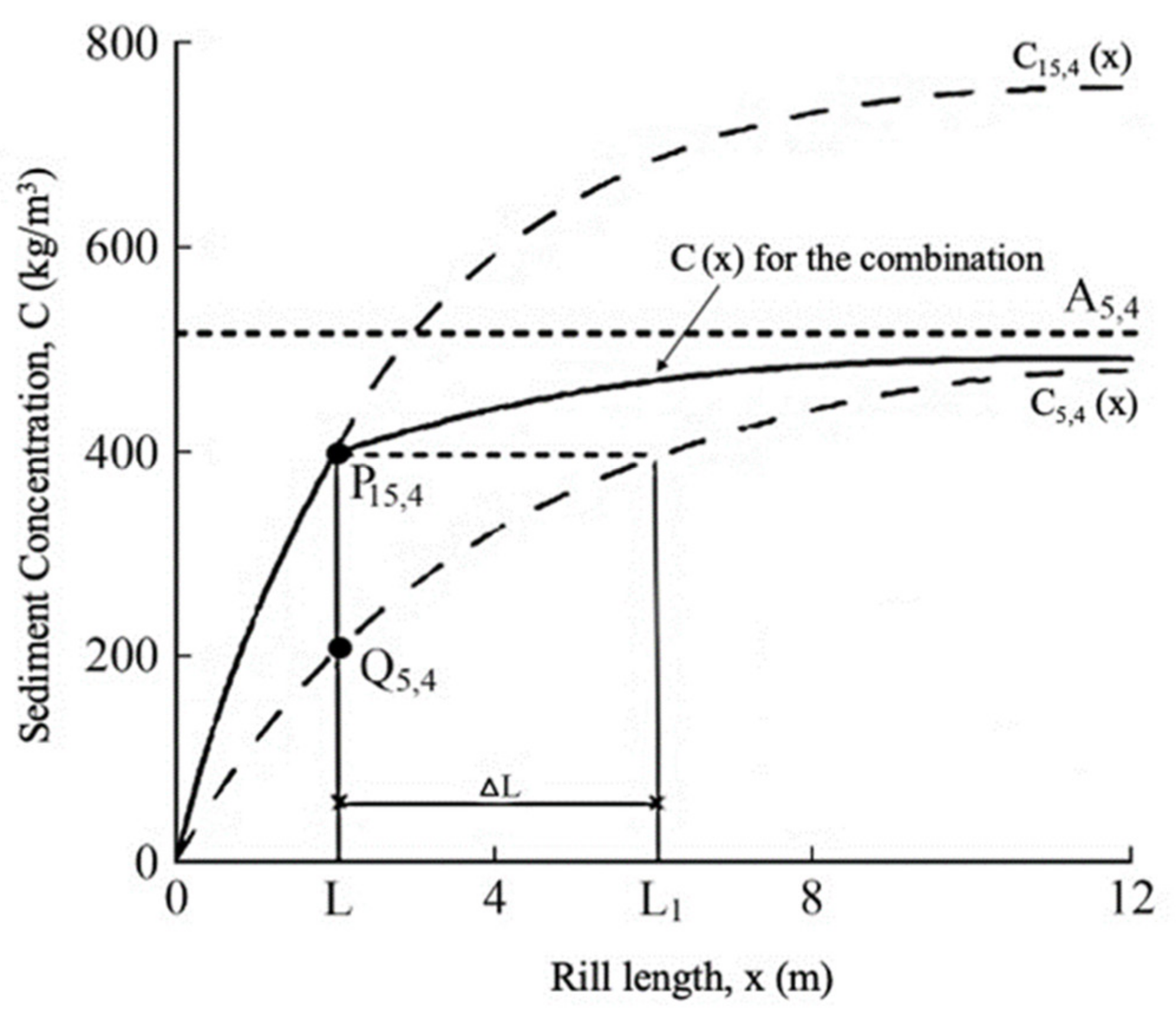
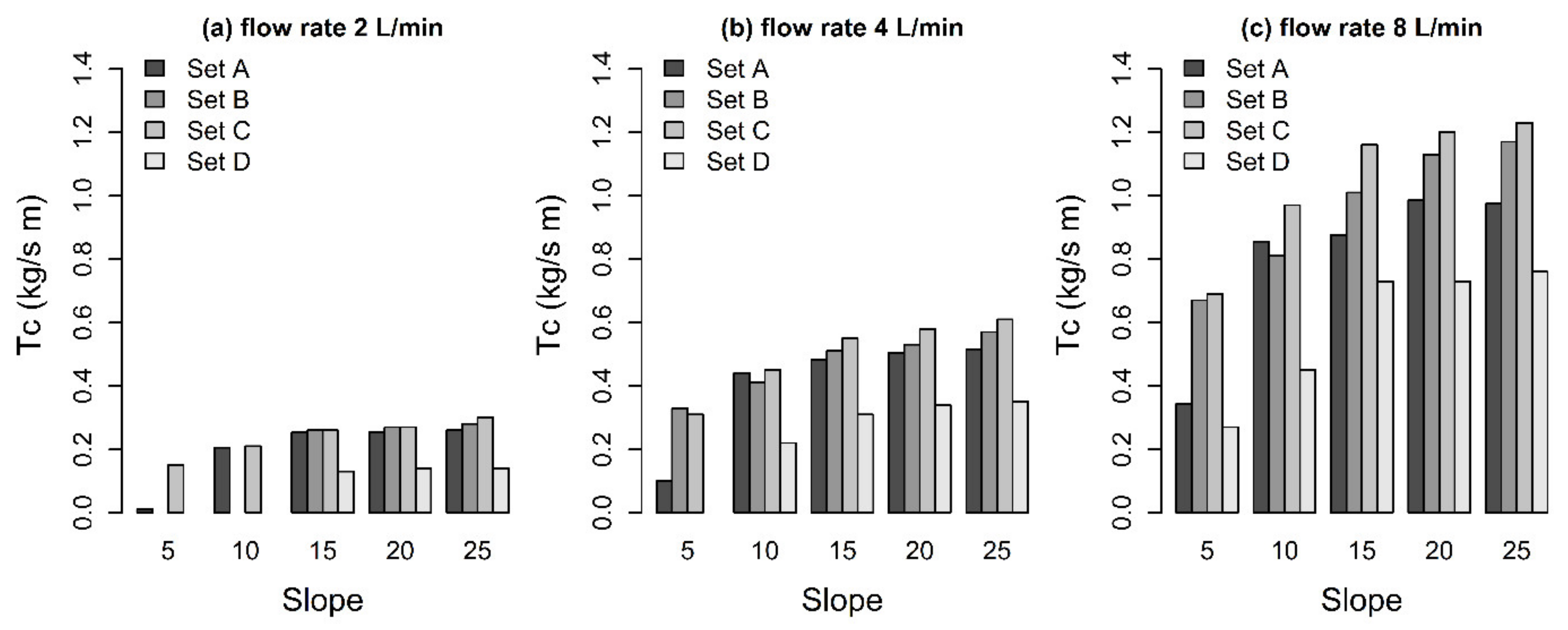
| Slope | Flow Rate (L min−1) | |||||||
|---|---|---|---|---|---|---|---|---|
| 2 | 4 | 8 | 16 | |||||
| Tc | Std | Tc | Std | Tc | Std | Tc | Std | |
| 5° (9%) | 0.011 | 0.0005 | 0.100 | 0.0018 | 0.344 | 0.0245 | 0.768 | 0.0082 |
| 10° (18%) | 0.205 | 0.0023 | 0.441 | 0.0155 | 0.855 | 0.0040 | 1.614 | 0.0142 |
| 15° (27%) | 0.254 | 0.0032 | 0.483 | 0.0017 | 0.876 | 0.0072 | 1.731 | 0.0396 |
| 20° (36%) | 0.255 | 0.0080 | 0.504 | 0.0153 | 0.985 | 0.0235 | 1.929 | 0.0391 |
| 25° (47%) | 0.260 | 0.0012 | 0.516 | 0.0042 | 0.975 | 0.0082 | 2.039 | 0.0086 |
| Estimates | Std | Error | t Value | Pr (>|t|) | |
|---|---|---|---|---|---|
| a | −0.427926 | 0.119260 | −3.588 | 0.002266 | 0.01 |
| b | 0.028460 | 0.006177 | 4.605 | 0.000251 | 0.001 |
| c | 0.101103 | 0.008145 | 12.412 | 5.99 × 10−10 | 0.001 |
| Slope (Measuring Flume) | Slope (Feeding Flume) | Flow Rates (L min−1) | ||
|---|---|---|---|---|
| 2 | 4 | 8 | ||
| 5° (9%) | 15° (27%) | 278 (-) | 308 (147) | 395 (190) |
| 10° (18%) | 20° (36%) | 442 (-) | 530 (242) | 501 (208) |
| 15° (27%) | 25° (47%) | 497 (278) | 543 (308) | 507 (395) |
| Slope | q L min−1 | ΔL 1 m | Lreq 2 m | Leq 3 m | E8 4 % |
|---|---|---|---|---|---|
| 5° | 2 | - | - | - | |
| 4 | 4.60 | 12.50 | 12.60 | 24.67 | |
| 8 | 9.63 | 11.54 | 14.93 | 22.45 | |
| 10° | 2 | - | - | - | |
| 4 | 3.36 | 8.82 | 11.36 | 16.59 | |
| 8 | 4.52 | 8.82 | 12.52 | 16.59 | |
| 15° | 2 | 0.73 | 7.50 | 8.73 | - |
| 4 | 1.39 | 8.11 | 9.39 | 16.18 | |
| 8 | 1.21 | 6.67 | 9.21 | - |
| Data Set | Soil Texture | Bulk Density | Flume Length | ||
|---|---|---|---|---|---|
| Clay% | Silt% | Sand% | g cm−3 | m | |
| Current study | 14.2 | 44.9 | 40.9 | 1.2 | 8 |
| Loess Soil (Lei et al. 2001) [12] | 15.9 | 63.9 | 20.2 | 1.2–1.3 | 8 |
| Loess Soil (Chen et al. 2015) [31] | 15.92 | 63.90 | 20.18 | 1.2 | 12 |
| Purple Soil (Chen et al. 2015) [31] | 38.65 | 35.74 | 25.61 | 1.2 | 12 |
Disclaimer/Publisher’s Note: The statements, opinions and data contained in all publications are solely those of the individual author(s) and contributor(s) and not of MDPI and/or the editor(s). MDPI and/or the editor(s) disclaim responsibility for any injury to people or property resulting from any ideas, methods, instructions or products referred to in the content. |
© 2023 by the authors. Licensee MDPI, Basel, Switzerland. This article is an open access article distributed under the terms and conditions of the Creative Commons Attribution (CC BY) license (https://creativecommons.org/licenses/by/4.0/).
Share and Cite
Qu, L.; Lei, T.; Zhou, C.; Yang, X. Measuring Sediment Transport Capacity of Concentrated Flow with Erosion Feeding Method. Land 2023, 12, 411. https://doi.org/10.3390/land12020411
Qu L, Lei T, Zhou C, Yang X. Measuring Sediment Transport Capacity of Concentrated Flow with Erosion Feeding Method. Land. 2023; 12(2):411. https://doi.org/10.3390/land12020411
Chicago/Turabian StyleQu, Liqin, Tingwu Lei, Chenyan Zhou, and Xiusheng Yang. 2023. "Measuring Sediment Transport Capacity of Concentrated Flow with Erosion Feeding Method" Land 12, no. 2: 411. https://doi.org/10.3390/land12020411
APA StyleQu, L., Lei, T., Zhou, C., & Yang, X. (2023). Measuring Sediment Transport Capacity of Concentrated Flow with Erosion Feeding Method. Land, 12(2), 411. https://doi.org/10.3390/land12020411






